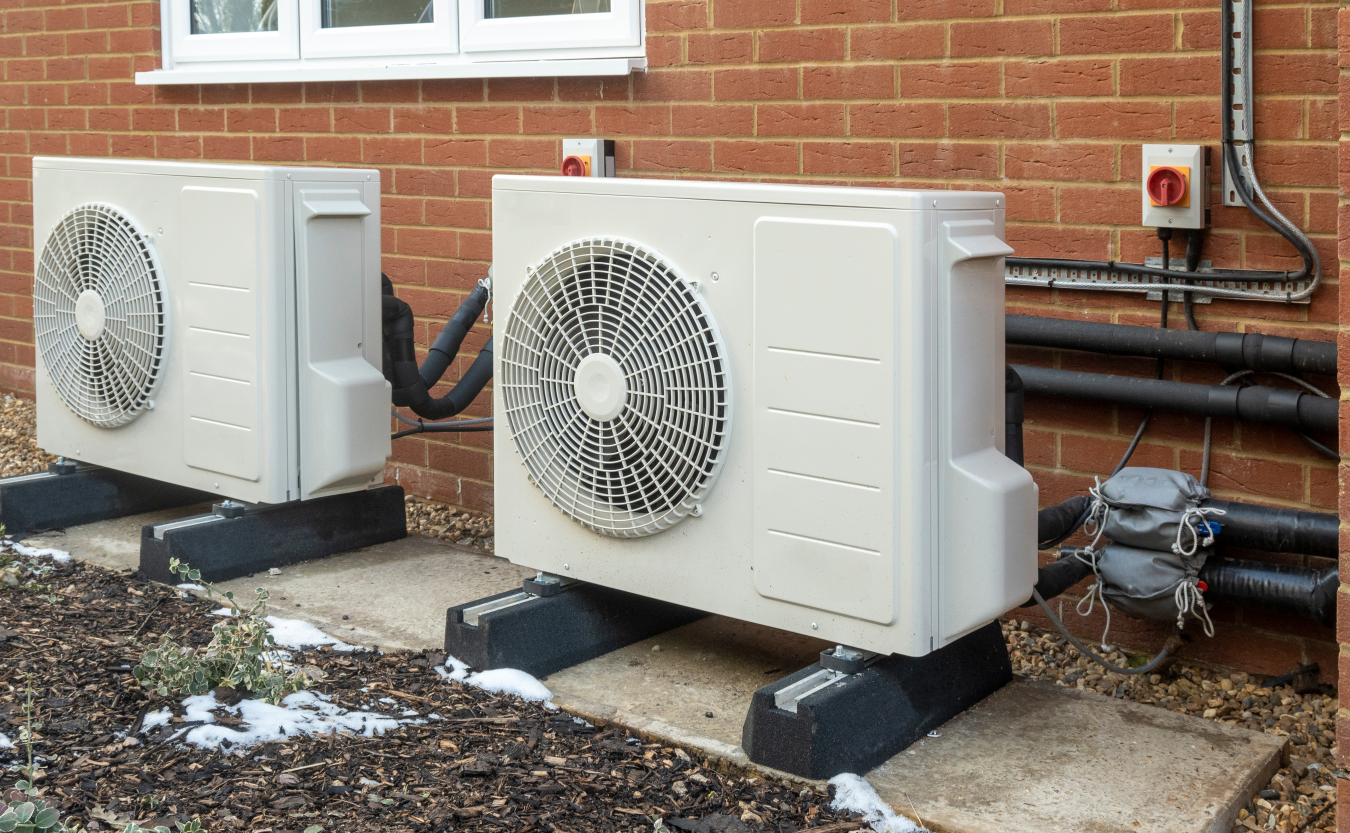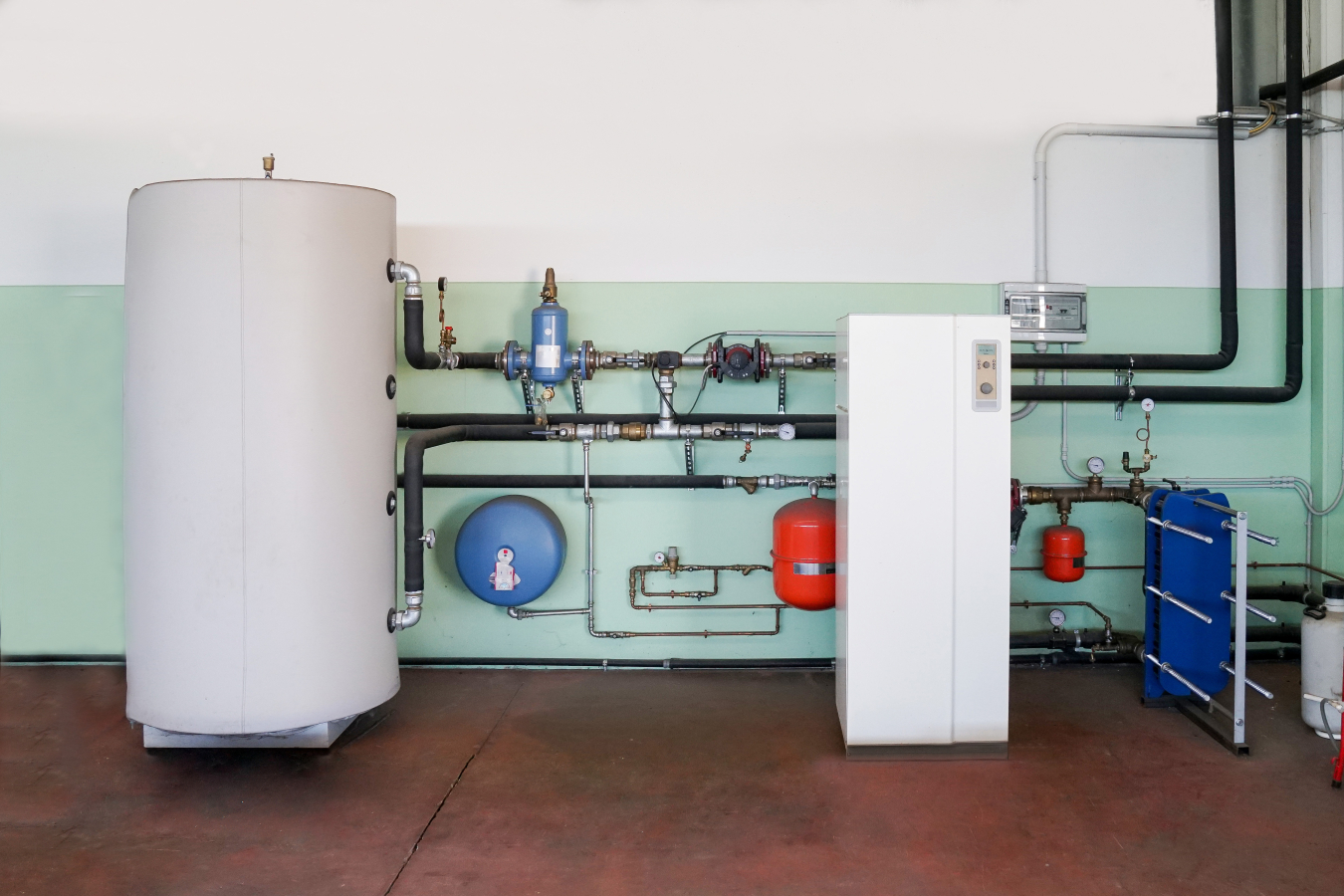Heat pumps offer an energy-efficient alternative to furnaces and air conditioners for all climates. Like your refrigerator, heat pumps use electricity to transfer heat from a cool space to a warm space, making the cool space cooler and the warm space warmer. During the cooling season, heat pumps move heat from your house to the outdoors, and during the heating season, they move heat from the cool outdoors into your warm house. Because they transfer heat rather than generate heat, heat pumps can efficiently provide comfortable temperatures for your home.
Types of Heat Pumps
There are two main types of heat pumps connected by ductwork: air-to-air and ground-source or geothermal. These systems collect heat from the air or ground outside your home and concentrate it for use inside. Absorption heat pumps, or gas-fired heat pumps, use heat or thermal energy as their energy source.

Ducted Air-Source Heat Pumps
The most common type of heat pump is the air-source heat pump, which transfers heat between your house and the outside air. Today's heat pump can reduce your electricity use for heating by up to 75% compared to electric resistance heating such as furnaces and baseboard heaters. High-efficiency heat pumps also dehumidify better than standard central air conditioners, resulting in less energy usage and more cooling comfort in summer months.
Air-source heat pumps have been used for many years in nearly all parts of the United States, but they've not always been used in areas that experience extended periods of subfreezing temperatures. However, advancements in air-source heat pump technology now offer a legitimate space heating alternative in colder regions. Existing homeowners looking to replace a gas heating system with a heat pump should weatherize their homes to ensure optimal cost savings and comfort, especially in older homes. For more information on home upgrades, visit the ENERGY STAR Home Upgrade platform.
Consider upgrading to an ENERGY STAR® certified heat pump for better efficiency and lower operating costs. Learn more about ENERGY STAR® certified heat pumps.

Ductless Air-Source Heat Pumps
Ductless air-source heat pumps offer an efficient and flexible solution for heating and cooling homes without existing ductwork. These systems are ideal for zone heating and can significantly lower energy use compared to traditional heating methods. Additionally, air-to-water heat pumps, another ductless option, provide heating via hot water through radiant floors or radiators, though they don’t offer cooling.
Minisplit Heat Pumps
Minisplit heat pumps, a ductless air-source variant, are highly effective for homes without ductwork, offering an efficient alternative to baseboard heating. These systems can reduce energy costs significantly, especially for zone heating. While other configurations, such as air-to-water heat pumps, exist, minisplits are the most common solution for homes with radiator heating in regions like New England and the Mid-Atlantic, where ducted systems are less prevalent.
Additional Context:
- In warmer climates (zones 1-4), about 60% of homes rely on furnaces, while heat pumps are used in 15%-25% of homes, especially mobile homes. Approximately 12%-25% of homes have systems without ductwork, which makes minisplits a viable option (Building America Solution Center) (ENERGY STAR).
- In colder climates (zones 5-7), furnaces are indeed the dominant heating system, used in approximately 63% of homes. Heat pumps, although more efficient in some cases, account for only about 3% of the primary heating systems in these regions. Additionally, around 32% of homes in these areas lack ductwork, making ductless solutions like minisplit heat pumps a practical option for those looking to switch to more energy-efficient systems (EnergySage) (EnergySage) (Bob Vila).
For homes with existing ductwork, replacing a furnace with a heat pump or installing a hybrid system is often easier. However, for homes without ductwork, minisplit systems are generally the best retrofit option. For new home construction, various configurations are available, but cost and specific climate conditions usually influence the choice.
Reverse Cycle Chillers
A special type of air-source heat pump called a "reverse cycle chiller" generates hot and cold water rather than air, allowing it to be used with radiant floor heating systems in heating mode.

Geothermal, or Ground-Source, Heat Pumps
Geothermal heat pumps, also referred to as GHPs, achieve higher efficiencies by transferring heat between your house and the ground. Even though the installation price of a geothermal system can be several times that of an air-source system of the same heating and cooling capacity, the additional costs may be returned in energy savings in 5 to 10 years, depending on the cost of energy and available incentives in your area. System life is estimated at up to 24 years for the inside components and 50+ years for the ground loop.
Geothermal heat pumps have some major advantages. High-efficiency geothermal heat pumps, like ENERGY STAR-certified heat pumps, use 61% less energy than a standard model, control humidity, are sturdy and reliable, and fit in various homes.
A qualified installer or contractor can help ensure the highest efficiencies from a geothermal heat pump system based on site characteristics and intended use, and can provide information on any regulations or permitting that might be required.
For more information, visit the Geothermal Technologies Office website and ENERGY STAR certified geothermal heat pumps.

Absorption Heat Pumps
Absorption heat pumps, also called gas-fired heat pumps, use heat or thermal energy as their energy source. They differ from compression heat pumps driven by mechanical energy and can be powered by various heat sources such as natural gas, steam, solar-heated water, or geothermal-heated water. Absorption heat pumps are more complex and require larger units compared to compressor-based heat pumps. The main advantage is their lower electricity demand, which is limited to liquid pumping.

Energy Rebates and Tax Credits
Search for rebates and tax credits for home energy upgrades and efficient products
Advanced Heat Pump Technologies
Several innovations are improving the performance of heat pumps:
Staged or Multi-Speed Compressors
- Staged or multi-speed compressors let heat pumps operate close to the heating or cooling capacity needed at any outdoor temperature.
- These systems save energy by reducing on/off operation and compressor wear.
- Inverter-driven systems can modulate their speed/capacity at near-infinite degrees between low and high settings, running efficiently and maintaining consistent comfort.
Variable-Speed or Dual-Speed Motors
- Most newer models of heat pumps and furnace blowers are equipped with electrically commutated motors (ECM) or variable-speed or dual-speed motors on their indoor fans, outdoor fans, or both.
- Variable-speed controls for these fans keep the air moving at a comfortable velocity, minimizing cool drafts, maximizing electrical savings, and reducing noise and disruption.
Desuperheater
- Some high-efficiency heat pumps are equipped with a desuperheater, which recovers waste heat from the heat pump's cooling mode and uses it to heat water.
- A desuperheater-equipped heat pump can heat water 2 to 3 times more efficiently than an ordinary electric-resistance water heater.
Dual-Fuel or Hybrid Systems
Dual-fuel or hybrid systems combine the efficiency of a heat pump with the reliability of a gas furnace. This combination allows the heat pump to handle most of the heating needs in milder weather, while the furnace takes over during colder temperatures.
How It Works:
- Energy Efficiency: During warmer months, the heat pump efficiently heats and cools your home. When temperatures drop, the system automatically switches to the gas furnace, which is better suited for cold weather.
- Shared Ductwork: Both systems typically use the same ductwork, making it a straightforward installation if you’re upgrading from a traditional furnace and air conditioning setup.
- Widely Available: Commonly found in regions like the Mid-Atlantic, dual-fuel systems are easy to implement and help homeowners reduce electricity use in cold climates while maintaining comfort year-round.
This setup is a great option for homeowners looking to maximize energy savings while ensuring reliable heating in colder weather.
Cold Climate Heat Pumps
- Cold climate heat pumps are designed to perform in temperatures as low as 5°F.
- If you live in a region where temperatures regularly dip below freezing in winter months, consider looking for a system with an ENERGY STAR Cold Climate label.
- Learn more about ENERGY STAR Cold Climate heat pumps.
Conclusion
Heat pumps offer an energy-efficient and versatile solution for heating and cooling your home. With advancements in technology, they are now suitable for a variety of climates and applications. Whether you choose air-source, ductless, ground-source, or advanced heat pump systems, you can enjoy comfortable temperatures and energy savings.
Take Action
Upgrade to an ENERGY STAR® certified heat pump to maximize energy efficiency and comfort in your home. For more information and to explore your options, visit the ENERGY STAR® certified heat pumps page. Start saving energy and reducing your carbon footprint today!
Subscribe to receive updates and energy-saving tips for consumers and homeowners.

